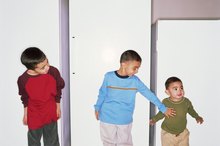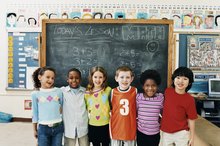Examples of Respectful Behavior in Children
Respect is an important skill, one that will help children succeed when they are young and as they become adults. As you lead and guide your children, you may look eagerly for signs that they are learning how to behave respectfully. Chances are, with a little observation, you will see various examples and incidences of respectful behavior.
Admitting Mistakes
The ability to examine conduct and actions and see errors and mistakes is a respectful way to act, states Faden Fulleylove-Krause and Roberta Lawonn, family living educators with the University of Wisconsin. This self-examination applies to virtually anyone, child or adult. The process of admitting a mistake and apologizing for it demonstrates a contriteness and repentance, and shows respect for others’ feelings. Parents who set a positive example of admitting mistakes and apologizing when necessary teach children that mistakes happen but that the important thing is to admit the mistake, apologize and move on.
- The ability to examine conduct and actions and see errors and mistakes is a respectful way to act, states Faden Fulleylove-Krause and Roberta Lawonn, family living educators with the University of Wisconsin.
- The process of admitting a mistake and apologizing for it demonstrates a contriteness and repentance, and shows respect for others’ feelings.
Courtesies
Dance and Social Development in Preschool Children
Learn More
Using common courtesies in communicating, conversing and interacting with others is another way children can demonstrate respectful behavior, according to Fulleylove-Krause and Lawonn. When children use manners such as “Thank you,” “Please” and “Excuse me” in conversations, it shows polite respect. Teach children to maintain eye contact with others to show interest and concern. Sharing and working cooperatively with others is another way to demonstrate respect, states Marilyn Ellis, a specialist with the University of Maine.
- Using common courtesies in communicating, conversing and interacting with others is another way children can demonstrate respectful behavior, according to Fulleylove-Krause and Lawonn.
Privacy
Teach children to respect the privacy of others. Privacy includes the property of others as well as information pertaining to others. Children should not invade other people’s belongings, including bedrooms or other personal spaces. Children should also not read personal messages or mail, or eavesdrop on private conversations. Respecting privacy is a respect for personal boundaries. Personal boundaries are important for everyone, adults and children alike.
- Teach children to respect the privacy of others.
- Children should not invade other people’s belongings, including bedrooms or other personal spaces.
Empathy
Reconciliation Activities for Kids
Learn More
Empathy is an important tenet of respect, according to Ellis. Help children learn skills of caring and perceiving how other people feel in various situations. When someone feels sad, frightened or angry, talk about the various situations to explore what happened and what should happen next. The more children practice learning empathy by recognizing and talking about feelings, the better they become at feeling empathy when interacting with other people. An example of an empathic response from a child might be a girl noticing another girl watching children playing on the swings on the playground. After swinging for a few moments, the first girl hops down from the swing and invites the other girl to take a turn. The first child recognized sadness and yearning for a turn and felt motivated to demonstrate care for the other child by sharing.
- Empathy is an important tenet of respect, according to Ellis.
- When someone feels sad, frightened or angry, talk about the various situations to explore what happened and what should happen next.
Related Articles
Writer Bio
Kathryn Hatter is a veteran home-school educator, as well as an accomplished gardener, quilter, crocheter, cook, decorator and digital graphics creator. As a regular contributor to Natural News, many of Hatter's Internet publications focus on natural health and parenting. Hatter has also had publication on home improvement websites such as Redbeacon.









